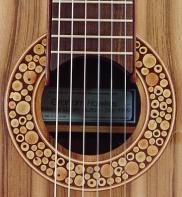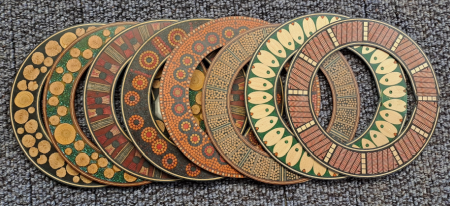Design of Guitars
Sound

Rosette of sheoak twigs cut in cross section
and set in epoxy resin
Graham Hawkes builds classical guitars with modern design features. These features create an instrument that produces a strong even sound with full deep basses and rich sustained trebles. The design also satisfies demands for a wide range of tonal colours and an instrument that is easy to play. Words however go only part of the way. A CD is available of music recorded by talented guitarist Kathryn Weir playing one of these instruments.
New Skills - Old Traditions
These guitars combine the skills of traditional guitar making and modern technology with an added something which is uniquely Australian. The beautiful guitars of Josef Pages and Louis Panormo - two of the leading guitar makers in Spain and England in the 19th century are the source of design for the shape of the head piece and neck.
Modern technology
While the natural resonance of the timber is the basis of the guitar sound, thoughtful use is made of modern products to give each guitar a rich tonal quality (eg. Carbon fibre to re-enforce the sound board).

Head with Jarrah face
Native timbers
Many timbers native to Western Australian have qualities which can produce fine instruments. The guitars are made with various combinations of Sheoak, Jarrah, Wandoo, Silky Oak and Western Myall whichare shown in the page titled 'Instruments". All timbers are native to Western Australia except for the sound boards which are made from traditional tone woods such as Red Cedar or Spruce.
Decorations
Each guitar is unique in some way. It could have decorations in native timbers or cross cut twigs. Some guitars have decorative motifs inspired by designs in Aboriginal art works. Great care has been taken in the design and use to respect Aboriginal culture.

Design
The modern design combines best construction practice, local timbers, original decorations and the option of a solution to the problem of string tension.
Features of the design are:-
- carbon fibre re-inforcement of the sound board,
- decoration made uniquely for each instrument,
- distinctive Panormo inspired headpiece, and
- neck extends through to the top fret.
Because the instruments are hand made, there is a rich variety of options from which to choose.
| Options |
| Soundboard of Cedar or Spruce. |
| "Arm rest" - a raised edge along the bass side of the lower bout which can help reduce contact between the player's arm or sleeve and the sound board. |
| Body with a cutaway. = + $100 |
| Left handed. |
| Dots on the fretboard. |
| 650 mm or 630 string length. |
| "Lacote" bridge with tailpiece = + $100
The celebrated 19th century French luthier René Lacote built guitars with a tailpiece or cordier. Napoleon Coste played such an instrument. With the Lacote bridge strings of any tension can be fitted. The design frees the soundboard from a string tension of approximately 40 kgs. |
Return to the top of this page.


